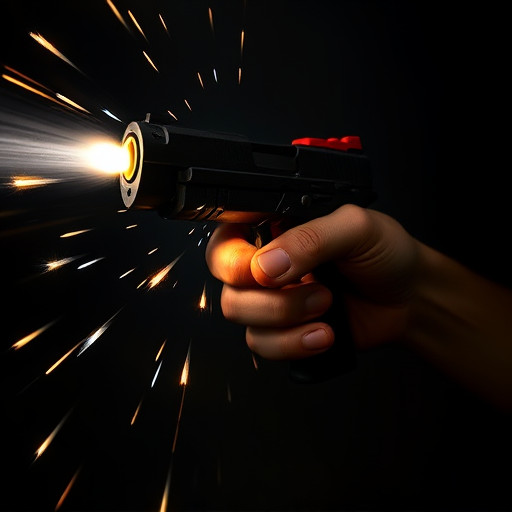Stun guns, or Tasers, are non-lethal weapons that render individuals unconscious through an electric current, providing law enforcement with a safe de-escalation tool. Their effectiveness lies in temporary muscle disruption, but varies based on individual factors. Proper training is crucial to maximize their benefits while minimizing risks and ethical concerns surrounding their use persist globally.
“Uncovering the Stun Gun’s Effectiveness: A Comprehensive Look explores the impact of taser guns in modern law enforcement. From understanding their mechanical action to evaluating their performance in real-world scenarios, this article delves into the pros and cons. We analyze how stun guns alter physical confrontations, examine safety protocols and training requirements, and discuss legal frameworks and ethical considerations surrounding their use. Discover why exploring stun gun effectiveness is crucial for navigating today’s public safety landscape.”
Understanding Stun Guns: How Do They Work?
Stun guns, also known as electroshock weapons, are designed to incapacitate a target by delivering an electric current that overrides their motor functions. Unlike traditional firearms, stun guns don’t fire bullets; instead, they emit a high-voltage, low-amperage electrical pulse. This pulse disrupts the nervous system, causing muscle spasms and temporary paralysis. The effect is immediate but typically lasts for only a few seconds, allowing law enforcement officers to safely control and subdue an individual without causing permanent harm.
The stun gun’s effectiveness lies in its ability to disable attackers quickly and non-lethalily. Studies show that when used correctly, stun guns can render a subject unconscious for several minutes, providing crucial time for backup or de-escalation strategies. However, their impact on individuals with different body types, medical conditions, or resistance levels can vary, emphasizing the importance of proper training in their use.
Taser Gun Effectiveness in Law Enforcement Scenarios
Taser guns, also known as stun guns, have become a staple in law enforcement scenarios worldwide due to their demonstrated effectiveness in de-escalating potentially dangerous situations. These non-lethal weapons use electrical current to disrupt muscular control, temporarily incapacitating the target without causing permanent harm. Studies show that when used appropriately, taser guns can quickly subdue individuals who pose a threat, giving officers valuable time to assess and manage the situation further.
In police interactions, stun guns have proven especially useful in dealing with resistant or aggressive subjects. By delivering a powerful but controlled electric shock, they enable officers to gain control more swiftly than traditional physical force, reducing the risk of injury to both suspects and officers. This effectiveness has led to increased adoption by law enforcement agencies, who recognize their potential to mitigate violence and ensure safer outcomes in various high-risk encounters.
The Impact on Physical Confrontations
In physical confrontations, a stun gun (or Taser) offers a non-lethal alternative to traditional firearms, providing officers with enhanced control and de-escalation capabilities. The device delivers an electric shock that temporarily disables the target, allowing for safe restraint and arrest without the risk of fatal injuries. This is particularly useful in situations where force must be applied but the potential for harm needs to be minimized.
The stun gun’s effectiveness lies in its ability to disrupt muscle control, causing the individual to experience a powerful, yet non-deadly, force. This disruption can lead to immediate compliance and immobilization, making it an invaluable tool for law enforcement agencies worldwide. The shock not only provides a surprise element but also serves as a last resort when facing resistant or aggressive individuals.
Safety and Training Considerations
When discussing the stun gun effectiveness, it’s crucial to address safety and training considerations. Stun guns, or Tasers, are powerful tools designed to incapacitate individuals temporarily through electrical pulses, significantly reducing their ability to move or resist. However, their use comes with significant responsibilities. Law enforcement agencies and individuals authorized to carry stun guns must undergo rigorous training to ensure safe and responsible deployment, minimizing the risk of accidental harm to bystanders or the intended target.
Proper training involves learning safe handling practices, understanding the weapon’s range and activation mechanisms, and developing tactical strategies for different scenarios. It also includes de-escalation techniques and awareness of legal implications, ensuring that stun guns are only used as a last resort when necessary for self-defense or to control aggressive individuals. Adequate training is key to maximizing stun gun effectiveness while upholding public safety.
Legal Implications and Ethical Debates
The use of Taser guns, or stun guns, has sparked intense legal and ethical discussions worldwide due to their unique effectiveness in immobilizing individuals. While many advocate for their use as a less-lethal alternative to firearms, particularly in de-escalation scenarios, others raise concerns about potential misuse and unintended consequences.
Legal implications vary across jurisdictions, with some countries embracing Tasers as a legal force option, while others remain cautious due to incidents of excessive force. Ethical debates center around the weapon’s ability to cause temporary but significant discomfort, raising questions about consent, proportionality, and the potential for harm, especially in individuals with medical conditions or those under the influence of substances. The effectiveness of Tasers as a tool for law enforcement has led to ongoing conversations about their role in modern policing strategies, balancing public safety with respect for individual rights.
